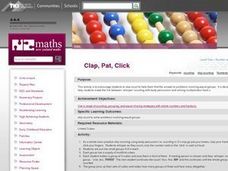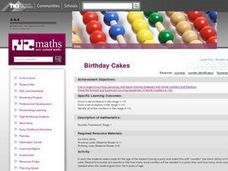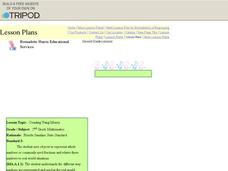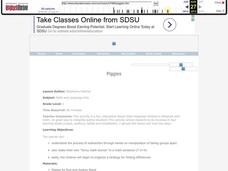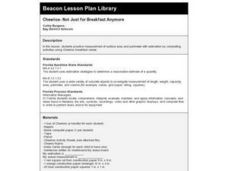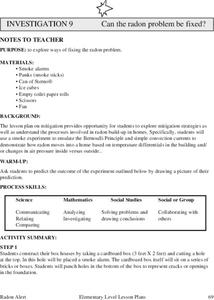Curated OER
Square Numbers
Fourth graders demonstrate multiple ways to represent whole numbers, decimals, and fractions. Through demonstration and hands-on activities they model square numbers using arrays. Students visually determine that the array makes a square.
Curated OER
Clap, Pat, Click
First graders practice the art of skip counting to help them find the answer to problems involving equal groups. They are encouraged to make the link between "whisper" counting with body percussion and solving multiplication facts.
Curated OER
Counting and Place Value
First graders use place value to practice counting, adding and subtracting using a phenomenological approach.
Curated OER
Place Value
First graders practice place value by completing problems that allow them to group 10 items together to create groups of 10 and see what is left over. In this place value lesson plan, 1st graders use cups to put 10 items in them, and...
Curated OER
Commutative Property
First graders investigate the Commutative Property of Addition. It is introduced using models such as students, counters, balances and dominoes. They discover the order of the numbers in an addition sentence does not change the result...
Curated OER
Birthday Cakes
Students use basic multiplication and division facts to find simple fractions of an amount. Independently they complete a worksheet of birthday cake problems, solving the fraction problems by drawing a picture to illustrate each cake...
Curated OER
Commutative Property
First graders use various models to learn the Commutative Property of Addition. In this Commutative Property lesson, 1st graders use other students, counters, balances, and dominoes to apply the addition property. Students solve addition...
Curated OER
Simplifying Equations of the Form ax+b=cx+d
Students solve equations of the form ax+b=cx+d and visualize the concept of "balancing" an equation.
Curated OER
Counting Using Money
Second graders count fake money by grouping like coins together. In this counting lesson plan, 2nd graders complete worksheets provided in this lesson plan.
Curated OER
Piggies
First graders listen to the book, Piggies, and act out the events of the story with premade puffball pigs.
Curated OER
Pattern Search
Third graders review the commutative and associative property in mathematics. Using a worksheet, they work together to identify the patterns between the 32 triangles. To end the lesson, they create their own array and exchange it with...
Curated OER
Data and Probability- What's the Chance?
Students investigate probability through a game. In this data lesson plan, students use dice and predictions to explore how probability works.
Curated OER
Sorting Through Life!
Students sort and count objects. In this sorting skills lesson plan, students work in small group with various objects that can be sorted and counted in groups.
Curated OER
Perimeter Playground
Students explore geometry by participating in a school measuring activity. In this perimeter lesson, students discuss the techniques and methods used in order to measure a large perimeter or geometric figure. Students utilize grid paper,...
Curated OER
Cheerios- Not Just for Breakfast Anymore
Second graders measure surface area and perimeter using estimation. They complete a variety of measurement activities using Cheerios breakfast cereal.
Curated OER
Slosh, Dribble, and Plop
Students recognize the need for a standard unit of volume. They estimate and measure to the nearest liter. Also they relate the liter to the familiar everyday containers.
Curated OER
Representing Rational Numbers
Seventh graders explore rational numbers. In this fractions, decimals, and percents instructional activity, 7th graders identify and compare equivalencies between fractions, decimals, and percents. Students use hands-on activities to...
Curated OER
3 dimensional shapes
Students play a bingo game to classify 3 dimensional shapes. In this 3 dimensional shapes lesson plan, students identify, describe, and classify shapes by playing a bingo game.
Curated OER
Guess the Color
High schoolers draw colored blocks from a bag and determine the probability of each color being drawn. Then they draw blocks from another bag in which the numbers of each color are unknown. They guess the number of each color included...
Curated OER
Addition and Subtraction Facts To 20
First graders use manipulatives, flash cards, number sentences and story problems to practice their addition and subtraction facts to twenty.
Curated OER
Long Division
Fourth graders acquire number sense and perform operations with whole numbers, simple fractions, and decimals.
Curated OER
Can The Radon Problem Be Fixed?
Students participate in lab activities in which they examine the radon level in homes. They demonstrate through convection currents how radon moves through a home based on temperature. They predict what they believe will occur during the...
Curated OER
Rolling For Value
Young scholars participate in a lesson to comprehend the concept of probability while rolling dice. They recognize patterns while making observations and recording the data for each roll. Students also review place values while playing a...
Curated OER
Two-Dimensional Drawings from Three-Dimensional Objects
Sixth graders identify and draw two-dimensional representations of a three-dimensional object. Students investigate the views of an object and determine that three views are required (front, one side and the top). Students use these...



